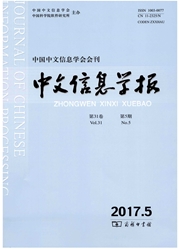

 中文摘要:
中文摘要:
该文以朱自清、汪曾祺和刘亮程的散文作品为语料,旨在从文本的韵律和节奏出发,采用文本聚类的方法来挖掘出新的能够代表作品风格的特征.实验表明,以句末用字韵母的n元组合、分句句长的n元组合、标点符号和整句句长作为风格特征,能成功地将这三位作家的作品区分开来.其中刘亮程句尾韵的舌位高于汪、朱二人,朱自清对韵脚的选择不如刘、汪二人丰富.汪曾祺的分句长最短,且最为讲究句式长短的对齐;刘亮程兼顾长短句的交错,节奏更富于变化;朱自清的句长变化最为平稳.
 英文摘要:
英文摘要:
We selected literary proses written by Ziqing Zhu, Zengqi Wang and Liangcheng Liu as corpora. Text clustering is used to mine new stylistic features from the perspective of rhythm and tempo. The experimental results show that n-grams based on the vowels of the last character of thesentence, n-grams based on the length of clauses, punctuations and length of sentences, all can successfully distinguish from the articles of the three authors. Specific- ally, Liangcheng Liu preferred to utilize the vowels of higher tongue position. Ziqing Zhu focused on some specific rhymes, but the rhymes used by Liu and Wang are more plentiful than those of Zhu. Wang's Clauses are the shor- test, and he paid more attention to the order of sentence patterns. Long sentences and short sentences are alterna- tively used by Liu, and the tempos used by Liu are changeful. The sentence lengths used bv Zhu are less changeful.
 同期刊论文项目
同期刊论文项目
 同项目期刊论文
同项目期刊论文
 Activated PTHLH Coupling Feedback Phosphoinositide to G-protein Receptor Signal-Induced Cell Adhesio
Activated PTHLH Coupling Feedback Phosphoinositide to G-protein Receptor Signal-Induced Cell Adhesio Inhibited PTHLH downstream leukocyte adhesion-mediated protein amino acid N-linked glycosylation cou
Inhibited PTHLH downstream leukocyte adhesion-mediated protein amino acid N-linked glycosylation cou P-glycoprotein (ABCB1) Inhibited Network of Mitochondrion Transport along Microtubule and BMP Signal
P-glycoprotein (ABCB1) Inhibited Network of Mitochondrion Transport along Microtubule and BMP Signal Parathyroid Hormone-Like Hormone (PTHLH) Feedback Mitosis to Downstream DNA Replication Coupling Pos
Parathyroid Hormone-Like Hormone (PTHLH) Feedback Mitosis to Downstream DNA Replication Coupling Pos Signal Transducer and Activator of Transcription 2 (STAT2) Metabolism Coupling Postmitotic Outgrowth
Signal Transducer and Activator of Transcription 2 (STAT2) Metabolism Coupling Postmitotic Outgrowth Tissue-specific transplantation antigen P35B (TSTA3) immune response–mediated metabolism coupling ce
Tissue-specific transplantation antigen P35B (TSTA3) immune response–mediated metabolism coupling ce PTHLH Coupling Upstream Negative Regulation of Fatty Acid Biosynthesis and Wnt Receptor Signal to Do
PTHLH Coupling Upstream Negative Regulation of Fatty Acid Biosynthesis and Wnt Receptor Signal to Do Cytosolic Iron-Sulfur Protein Assembly 1 (CIAO1) Downstream Activation of Phospholipase A2 and Hormo
Cytosolic Iron-Sulfur Protein Assembly 1 (CIAO1) Downstream Activation of Phospholipase A2 and Hormo ALK Folic Acid Transport and Integrin Signal Induced-Angiogenesis Network in Human Hepatocellular Ca
ALK Folic Acid Transport and Integrin Signal Induced-Angiogenesis Network in Human Hepatocellular Ca Cartilage oligomeric matrix protein (COMP) matrix proteolysis to nucleus cell differentiation mechan
Cartilage oligomeric matrix protein (COMP) matrix proteolysis to nucleus cell differentiation mechan Cartilage oligomeric matrix protein (COMP)-mediated cell differentiation to proteolysis mechanism ne
Cartilage oligomeric matrix protein (COMP)-mediated cell differentiation to proteolysis mechanism ne High EGFR_1 inside-out activated inflammation-induced motility through SLC2A1- CCNB2- HMMR- KIF11- N
High EGFR_1 inside-out activated inflammation-induced motility through SLC2A1- CCNB2- HMMR- KIF11- N A Study on Chinese Quantitative Stylistic Features and Relation among Different Styles Based on Text
A Study on Chinese Quantitative Stylistic Features and Relation among Different Styles Based on Text Low glucose transporter SLC2A5-inhibited human normal adjacent lung adenocarcinoma cytoplasmic pro-B
Low glucose transporter SLC2A5-inhibited human normal adjacent lung adenocarcinoma cytoplasmic pro-B CAMK1 Phosphoinositide Signal-Mediated Protein Sorting and Transport Network in Human Hepatocellular
CAMK1 Phosphoinositide Signal-Mediated Protein Sorting and Transport Network in Human Hepatocellular 期刊信息
期刊信息
